- MOE
- National Parks of Japan
- Keramashoto National Park
- Characteristics
main body
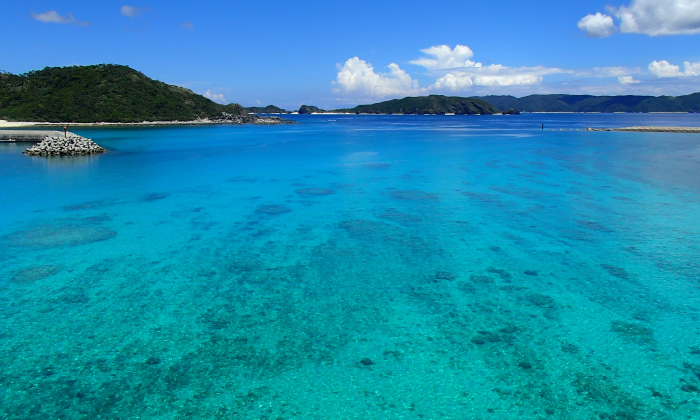
Characteristics
Okinawan Sea Kerama
The world of the Kerama Blue created by the ocean and islands
The world of the Kerama Blue created by the ocean and islands
Date of Designation: March 5, 2014
Area: 3,520 ha (land area)
Related Prefecture: Okinawa
Area: 3,520 ha (land area)
Related Prefecture: Okinawa
The Kerama Islands are located around 40 km west of Naha City, Okinawa Prefecture, comprising more than 30 islets and a number of rock reefs. The islands were designated the 31st National Park in Japan on March 5, 2014, which coincides with Coral Day.
The Kerama Islands boast a wide variety of landscapes extending from the land to the sea that include seascapes of exceptionally transparent waters, reefs densely populated by various species of corals, waters where humpback whales breed, sandy beaches, sea cliffs, the vegetation unique to windy regions, and the archipelago itself. The park includes a land area of 3,520 hectares, and 90,475 hectares of ocean area, which majority of its park area is the ocean.
With great accessibility because travel time is about 35 minutes to 50 minutes via high-speed vessel from the main land of Okinawa (Tomari Port, Naha City), visitors can experience scuba diving and snorkeling in a beautiful ocean renowned as the Kerama Blue and whale watching in winter.
The Kerama Islands boast a wide variety of landscapes extending from the land to the sea that include seascapes of exceptionally transparent waters, reefs densely populated by various species of corals, waters where humpback whales breed, sandy beaches, sea cliffs, the vegetation unique to windy regions, and the archipelago itself. The park includes a land area of 3,520 hectares, and 90,475 hectares of ocean area, which majority of its park area is the ocean.
With great accessibility because travel time is about 35 minutes to 50 minutes via high-speed vessel from the main land of Okinawa (Tomari Port, Naha City), visitors can experience scuba diving and snorkeling in a beautiful ocean renowned as the Kerama Blue and whale watching in winter.
Terrain/ Scenery

Although the Kerama Islands were originally a part of the mountains extending from the northern main island of Okinawa, a series of diastrophisms caused the land to precipitate, creating a collection of small islands as they are now. The inland sea of the Islands has the geographical features of a submerged shoreline, creating an archipelago landscape.
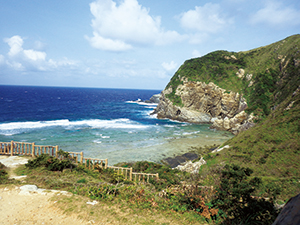
The mountain terrain approaches the coast and creates a ria coastline that abounds in imposing sea cliffs and indents. The side of the open sea has a well-developed marine landform and some areas have sea cliffs reaching 100 m to 200 m.
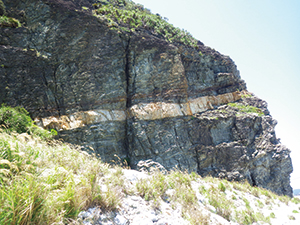
The geological features of the Kerama Islands belong to the Kunigami zone of the Mesozoic era including the foundations of crystalline schists, phyllites, and sandstone. The beaches facing an inland sea encompass shallow white sandy beaches consisting of coral fragments and the remains of foraminifera called star sand.
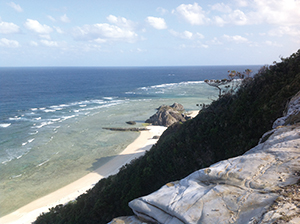
Tokashiki-jima Island
It is the largest island of the Kerama Islands and extends from north to south as a narrow strip to form a gentle hilly terrain across the board. The highest peak on the islands is Mt. Akama standing at 227.3 m.The periphery of Cape Aharen consists of sandstone cliffs where the vegetation distinct of a windy region creates magnificent scenery.
Zamami-jima Island
The island stretches lengthways from east to west and encompasses inlets to make a good natural harbor throughout the island. The greater part of the northern coast forms a precipitous cliff while the south of the island forms a gentle slope.
Aka-jima Island / Geruma-jima Island
Located in the heart of Zamami Village is a slightly diamond-shaped island, Aka-jiima Island. Most of the island is steep slopes. Geruma-jima Island is a roughly-quadrangular island with mountainous terrain throughout.
Plants
Land Plants
The Kerama Islands are located in the subtropical oceanic climate belt, and their ecosystems are especially unique in Japan.Fan palm forest and Ryukyu Island pine forest and over 620 species of native plants can be observed on the islands, which are characterized by their ecosystems of great variety of 46 tree species.
In winter, as the islands are largely affected by monsoons, the trees grow low across the forests to exhibit distinct vegetation unique to the trivialized windy region.
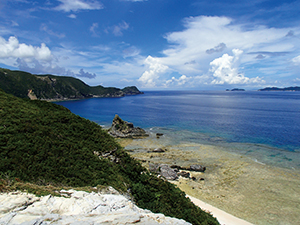
Wildlife
Land Animals
Small in size compared with Sika deer observed in Kyushu, Cervus nippon keramae is characterized by its smaller head and antler. Cervus nippon keramae and its habitat (Yakabi-jima Island and Geruma-jima Island ) are recognized as a national natural treasure.In addition, the islands are inhabited by threatened species such as and other diverse and rare wildlife and living creatures including Ryukyu flying fox, Japanese black-breasted leaf turtle, Ryukyu robin and Spotted ground gecko.
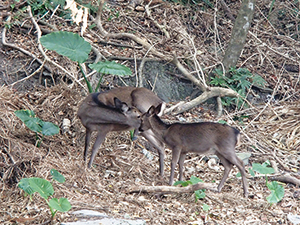
Yakabi-jima Island , a habitat for Japanese wood pigeon and other rare birds, and Keise-jima Island (Chibishi), a rookery of Common Tern have been designated a wildlife protection area of Okinawa Prefecture.
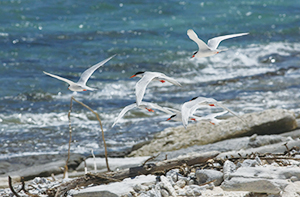
Coastal Area
The highly transparent adjacent sea around the Kerama Islands is densely populated by various species of corals, encompassing the nation's prominent beautiful seascapes. The area has been designated a Ramsar site in 2005.The sea area around the Kerama Islands is the habitat for densely populated reef-building corals in various shapes that include a table coral, branch coral, horned coral, and rock coral.
Having nearly 66.4 ha of coral reefs, the sea around the Kerama Islands is home to 248 species of reef-building corals, about 62% of the reef-building corals currently observed in Japan.
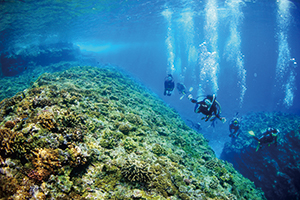
Around June of each year, the spawning of corals can be seen. Some of the surviving larvae of corals that are swept out off shore make their way to the west coast of the main island of Okinawa to adhere at the bottom of the sea. That is why the coral reef of Kerama is also important as a supply source of coral larva to the Okinawa main Island. The three-dimensional, complex structures of corals make a good habitat for many marine wildlife.
The coral reefs around the Kerama Islands are inhabited by a wide variety of colorful fish including damsel fish, butterfly fish, and the Labroidei.
The coral reefs around the Kerama Islands are inhabited by a wide variety of colorful fish including damsel fish, butterfly fish, and the Labroidei.
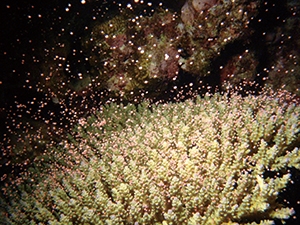
The waters off the Kerama Islands are a good observation spot for sea turtles such as green turtles and Hawksbill turtles.
When the summer comes around, the sea turtles make their landing on a sandy beach to lay eggs.
When the summer comes around, the sea turtles make their landing on a sandy beach to lay eggs.
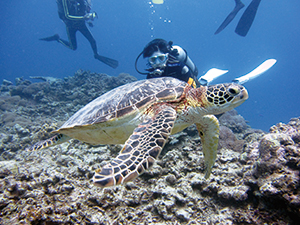
The peripheral or outer lying sea areas of the Kerama Islands are breeding grounds for humpback whales. Visitors can frequently observe humpback whales from December to April every year.
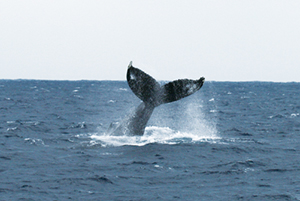
Culture
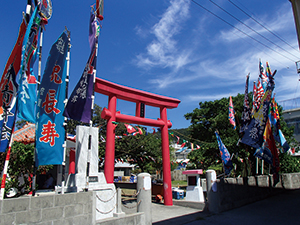
The Kerama Islands abound with sacred sites, shell mounds, historic sites and important cultural assets.
Life on the island is closely connected to the ocean. Each village has its own place of worship and follows traditions including an Okinawan festival held in the honor of the sea gods around August 20 in the lunar calendar, annual events such as Hamauri to pray for plentiful catches and safe voyages.
Life on the island is closely connected to the ocean. Each village has its own place of worship and follows traditions including an Okinawan festival held in the honor of the sea gods around August 20 in the lunar calendar, annual events such as Hamauri to pray for plentiful catches and safe voyages.

The islanders still treasure their traditions as the whole community gets together to knit a hay rope and twist it to make a thick rope to play a tug of war wishing for a good harvest.
With the history of being a stopping point of China-Ryukyu trade from the main island of Okinawa to China, the Takara Residence situated on Geruma-jima Island was said to have been built by a boatman who worked on a public ship that sailed to the Qing dynasty in the 19th century and at present, it is recognized as an National Important Cultural Property.
With the history of being a stopping point of China-Ryukyu trade from the main island of Okinawa to China, the Takara Residence situated on Geruma-jima Island was said to have been built by a boatman who worked on a public ship that sailed to the Qing dynasty in the 19th century and at present, it is recognized as an National Important Cultural Property.
History
The Kerama Islands are an island where the U.S. forces made their first landing during the Battle of Okinawa, and old battle sites can be found around the islands. The land previously used as a missile station for U.S. forces in the postwar period was returned to Japan along with the main island of Okinawa. The National Okinawa Youth Friendship Center was built as a symbol of the area's peaceful use.
